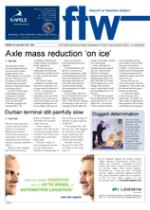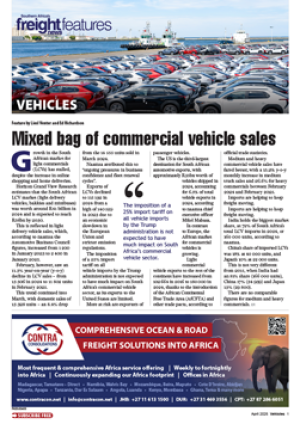The perennial problem
of container weight
misdeclaration once again
came under the spotlight
when Martyn Haines, senior
claims director, UK P&I
Club, addressed the industry
in London recently.
“Where container contents
turn out to have been
misdeclared in relation to
substance, volume, weight
and perhaps their dangerous
or illegal nature, the
shipper should have some
explaining to do,” said.
Haines. “However, this does
not stop the spotlight being
turned on owner and master
when things go wrong. They
will quickly find a range
of parties breathing down
their necks in their haste to
attribute liability.”
Not that lines are careless
about the weights they load.
They’re not, recognising that
overloaded and overweight
containers pose a serious
threat to the safety of crew
and vessels as they can affect
the stability of a ship.
But, even with all the care
taken, working out the weight
of a vessel’s payload is still
always a bit of a thumbsuck.
As Alex de Bruyn,
Safmarine SA trades
executive, told FTW recently,
the shipping lines use the
weights declared by shippers
on the shipping instruction
(SI) to determine the
maximum amount of cargo
that can be accepted for a
voyage, and to optimise the
revenue for that voyage.
“In other words,” he
added, “how much cargo
we can load before we reach
the required deadweight
limits (while also taking into
consideration the weight of
fuel, stores etc).”
But the lines have to make
a bit of a guesstimate in these
calculations.
“If shipping lines have
reason to ‘mistrust’ the
information which is
provided by shippers, they
will compensate accordingly
– always erring on the side
of caution,” De Bruyn said.
“In other words, lines will
assume container weights
are higher than declared and,
in the interests of safety of
crew and vessel, load fewer
boxes than can actually
be accommodated. While
the decision may be made
in the interests of safety,
the cost consequences of
‘short-loading’ a ship are
far-reaching and impact the
shipper in the end.”
Also, the huge liabilities
that can be incurred by ship
owners when containers are
lost overboard are frequently
compounded by the
problems of establishing the
circumstances surrounding
a particular incident and
incomplete knowledge of the
containers’ contents, says
Haines. “In our case the
incidents are isolated,
but it is an issue,” DAL
Agency Johannesburg
branch manager Roger
Phillip told FTW. “And
it’s a bigger issue than the
lines – impacting on our
infrastructure and road
system.
“From a stability and stow
perspective there are serious
implications for the line,
for the cranes, for the plate
rating on the containers
and for the vehicles moving
them on the inland leg,” he
added.
Another shipping line
spokesman said that the
problem would only be
rectified once the lines could
be assured that declared and
actual weights were one and
the same thing. And that
will only be possible with
Transnet buy-in in terms of
weighing equipment.
At the moment the lines
have to rely on the veracity
of their clients.
Information from shippers
about what’s in each box and
its weight can be inadequate,
misleading or inaccurate,
says Haines.
Mitsui OSK Line’s Iain
McIntosh agrees that it’s as
much of a problem as it ever
was.
“If they really wanted to
do something about it on
exports it would be simple,”
he added. “All you need
is a weighbridge at each
terminal.”
But so far Transnet has
not come to the party, and
until that happens, the
problem will continue.
Consumer ultimately pays the price for container weight misdeclaration
16 Jul 2010 - by Joy Orlek
0 Comments
FTW - 16 Jul 10

16 Jul 2010
16 Jul 2010
16 Jul 2010
16 Jul 2010
16 Jul 2010
16 Jul 2010
16 Jul 2010
16 Jul 2010
16 Jul 2010
Border Beat
Featured Jobs
New
New
